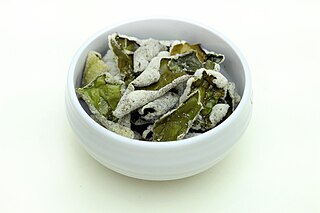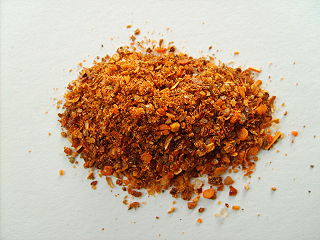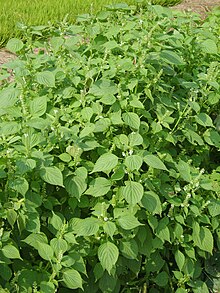
Korean cuisine has evolved through centuries of social and political change. Originating from ancient agricultural and nomadic traditions in Korea and southern Manchuria, Korean cuisine reflects a complex interaction of the natural environment and different cultural trends.

A chutney is a spread typically associated with cuisines of the Indian subcontinent. Chutneys are made in a wide variety of forms, such as a tomato relish, a ground peanut garnish, yogurt or curd, cucumber, spicy coconut, spicy onion or mint dipping sauce.

Perilla frutescensvar.crispa, also known by its Japanese name shiso, is a cultigen of Perilla frutescens, an herb in the mint family Lamiaceae. It is native to the mountainous regions of China and India, but is now found worldwide. The plant occurs in several forms, as defined by the characteristics of their leaves, including red, green, bicolor, and ruffled. Shiso is perennial and may be cultivated as an annual in temperate climates. Different parts of the plant are used in East Asian and Southeast Asian cuisine.

Tamil cuisine is a culinary style of Tamil people originating in the southern Indian state of Tamil Nadu and neighboring Sri Lanka. Meats, along with rice, legumes, and lentils, are also popular. Dairy products and tamarind are used to provide sour flavors. On special occasions, traditional Tamil dishes are served in a traditional manner, using banana leaves in place of utensils. After eating, the banana leaves are then used as a secondary food for cattle. A typical breakfast meal consists of idli or dosa with chutney. Lunch includes rice, sambar, curd, kuzhambu, and rasam.

A garnish is an item or substance used as a decoration or embellishment accompanying a prepared food dish or drink. In many cases, it may give added or contrasting flavor. Some garnishes are selected mainly to augment the visual impact of the plate, while others are selected specifically for the flavor they may impart. This is in contrast to a condiment, a prepared sauce added to another food item primarily for its flavor. A food item which is served with garnish may be described as being garni, the French term for "garnished."

Levantine cuisine is the traditional cuisine of the Levant, in the sense of the rough area of former Ottoman Syria. The cuisine has similarities with Egyptian cuisine, North African cuisine and Ottoman cuisine. It is particularly known for its meze spreads of hot and cold dishes, most notably among them ful medames, hummus, tabbouleh and baba ghanoush, accompanied by bread.

Chili sauce and chili paste are condiments prepared with chili peppers.

Perilla ketone is a natural terpenoid that consists of a furan ring with a six-carbon side chain containing a ketone functional group. It is a colorless oil that is sensitive to oxygen, becoming colored upon standing. The ketone was identified in 1943 by Sebe as the main component of the essential oil of Perilla frutescens. Perilla ketone is present in the leaves and seeds of purple mint, which is toxic to some animals. When cattle and horses consume purple mint when grazing in fields in which it grows, the perilla ketone causes pulmonary edema leading to a condition sometimes called perilla mint toxicosis.

Perilla oil is an edible vegetable oil derived from perilla seeds. Having a distinct nutty aroma and taste, the oil pressed from the toasted perilla seeds is used as a flavor enhancer, condiment, and cooking oil in Korean cuisine. The oil pressed from untoasted perilla seeds is used for non-culinary purposes.

Bugak (부각) is a variety of vegetarian twigim in Korean cuisine. It is made by deep frying dried vegetables or seaweed coated with chapssal-pul and then drying them again. It is eaten as banchan or anju. Common ingredients are green chili peppers, perilla leaves, perilla inflorescence, camellia leaves, chrysanthemum leaves, burdock leaves, tree of heaven shoots, potatoes, gim (laver), and dasima (kelp). Vegetable oils such as perilla oil or soybean oil are typically used for frying.

Jangajji (장아찌) or pickled vegetables is a type of banchan made by pickling vegetables. Unlike kimchi, jangajji is non-fermented vegetables, usually pickled in soy sauce, soybean paste, or chili paste. Jangajji dishes are usually preserved for a long period of time, and served with a drizzle of sesame oil. Preserved foods like jangajji were developed to attain a certain level of vegetable consumption during the long, harsh winters on the Korean peninsula.

Merkén or merquén is a smoked chili pepper used as a condiment that is often combined with other ingredients when in ground form. Merkén is a traditional condiment in Mapuche cuisine in Chile.

Manipuri cuisine refers to the cuisine of Manipur, a state of northeastern India. Daily meals are based on rice, with a few side dishes of vegetables, fish and meat. A meal would usually have a vegetable stew called ensaang or athongba, flavored with dried or fried fish; stir-fried vegetables called kanghou; and a spicy item, which could be morok metpa, eromba, or singju. All piquant side dishes are accompanied by a choice of fresh herbs, collectively called maroi. The base and essence of Meitei cuisine is the fermented fish called ngari. Several dishes of meat, mostly chicken and pork, are cooked with unique recipes. As a result of religious taboos, however, the Meitei Pangals do not cook the latter.
Perilla may refer to any of the following subjects:

Perilla is a genus consisting of one major Asiatic crop species Perilla frutescens and a few wild species in nature belonging to the mint family, Lamiaceae. The genus encompasses several distinct varieties of Asian herb, seed, and vegetable crop, including P. frutescens (deulkkae) and P. frutescens var. crispa (shiso). The genus name Perilla is also a frequently employed common name ("perilla"), applicable to all varieties. Perilla varieties are cross-fertile and intra-specific hybridization occurs naturally. Some varieties are considered invasive.































